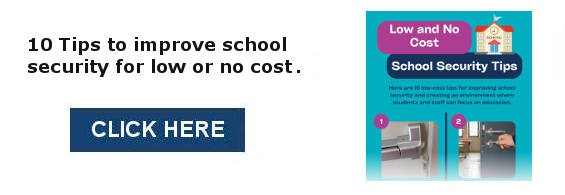While we all continue to keep up with the ever-evolving world of school security, we are constantly presented with new and possibly unfamiliar vocabulary. One that is most familiar among students and parents is “lockdown.” Whether schools are participating in drills or have to implement a real-life procedure, most school children and their parents will understand how a lockdown works and why it is important.
A lesser-known practice in a school’s safety and security routine sounds similar to a lockdown but requires very different security procedures. It is called a lockout.
As a previous school resource officer in several public schools, I participated in multiple lockdown drills. I am fortunate to never be in a lockdown response to an actual threat. I have, however, been in a real-life lockout, requiring staff to secure the school building and grounds. Below I will discuss the importance of the lockout and how it differs from the more familiar lockdown.
What is a School Lockout?
A lockout is a situation when the exterior of a building is secured in its entirety. A lockout requires securing the perimeter (doors and windows) of a building to minimize exposure to a potential threat outside. A way to remember is to think of your perspective from inside the building; you are locking out anyone trying to enter.
A lockout is usually in response to a dangerous situation in the community that school administrators or local law enforcement believe is not safe. The threat does not necessarily have to be near or related to the school for a lockout to occur.
All students and staff outside the building will come inside for safety during a lockout. Once everyone is inside, normal activities resume, such as class instruction, class changes, and lunch. In most situations, the school(s) involved in a lockout will post a sign at the front door to alert visitors that there is no entry into the school under any circumstance.
For schools with a campus layout, students and staff will remain in the building where they were when the lockout announcement was made. Class changes to other buildings on campus will not be allowed. Schools that allow recess or outdoor gym/sports activities will cancel outside events for all students until the lockout is lifted.
In short, under a lockdown, a school building is locked, and all staff and students go to a safe area to be silent and hide from a potential threat. In a lockout, the building is locked, but normal activities resume, except that no one can come in or out of the facility.
When to Use a Lockout
The situations in which a school would go into a lockout can vary from criminal activity in the area to the unknown whereabouts of a dangerous individual that is wanted by the local authorities. In these instances, the outcome of the situation is unknown. Based on the information given, law enforcement and/or the school administration will prioritize the safety of the students and staff by keeping everyone inside. The school will refuse the entry of visitors due to not knowing who or where the potential threat is located.
During my time as an SRO, a newsworthy incident occurred within the county that prompted local officials to place the school district on lockout. An armed suspect was believed to be in the community, and his whereabouts were unknown.
Since this threat was not directly related to the school, a lockout was enforced so the students could continue learning throughout the day. I was required to monitor the main entry door of the high school to verify that no visitors entered and no staff or students exited. This safety precaution led to minimal disruption for students and provided maximum protection for all school occupants.
Even though the incident was more than 20 minutes from my school, the lockout procedure guaranteed that the suspect would not enter the building and threaten school safety. Fortunately, the suspect was never close enough to be an actual threat to my school. However, the decision to be “better safe than sorry” should always be made when safety is a concern.
Note that the policies and procedures will vary between states and local jurisdictions regarding what is required of schools during these times. For example, parents may want to come to the school and take their child home when a lockout occurs. This is the personal preference of each parent and is allowed under many school policies.
Visitors who arrive on a school campus during a lockout will be greeted by an administrator or staff member at the front door. They will explain the situation and require identification that matches the student’s personal information card. If the visitor is confirmed as the child's parent or legal guardian, a staff member will escort the child from the building to the parent or guardian. The parent or guardian will not be allowed to enter the facility.
The Importance of a Lockout
Many questions arise with a lockout. Usually, the school district has a formal lockout policy for all schools to follow, but the schools do not practice lockout drills. This can potentially cause confusion when a lockout occurs. With the terminology similar to lockdown, it’s easy to understand that many parents believe their child’s school is in lockdown, suggesting an immediate threat on school grounds, which is a great cause for concern.
It's important to understand that a lockout is enforced with one priority in mind, to keep children safe from an unknown threat while continuing to allow students to have minimal disruption in their school routine. If your child has questions or concerns about a lockout, listen to what they say. Explain that there was a situation that wasn’t directly related to their school and reinforce the notion that they are safe in school.
In some situations, adults in the building feel that not allowing visitors inside is the best way to keep students and staff safe while allowing school activities to continue. Explain to your child that feeling concerned about something unfamiliar is okay. Children need to know their parents are a trusted resource and that they are in a safe place to express their concerns.
I hope this information has helped clear up any confusion between a lockout and a lockdown. In either situation, the utmost priority is the safety and security of our children. Knowledge is power regarding school safety; we can never know too much.
____________________________________________________________________________________________





-1.jpg)
.jpg)
.jpg)
.jpg)
-2.jpg)
.jpg)


.jpg)
.jpg)
.jpg)
.jpg)
.jpg)

